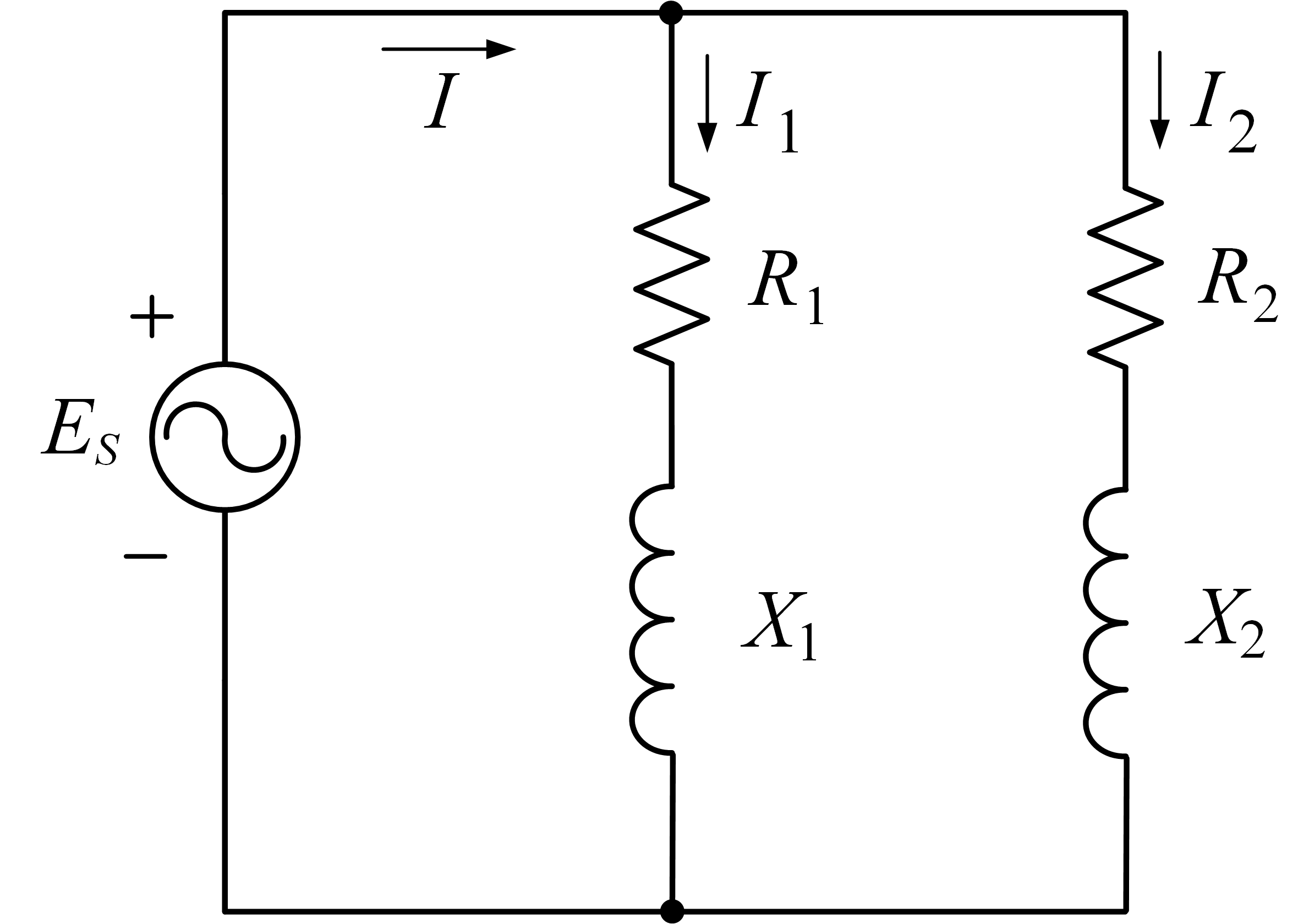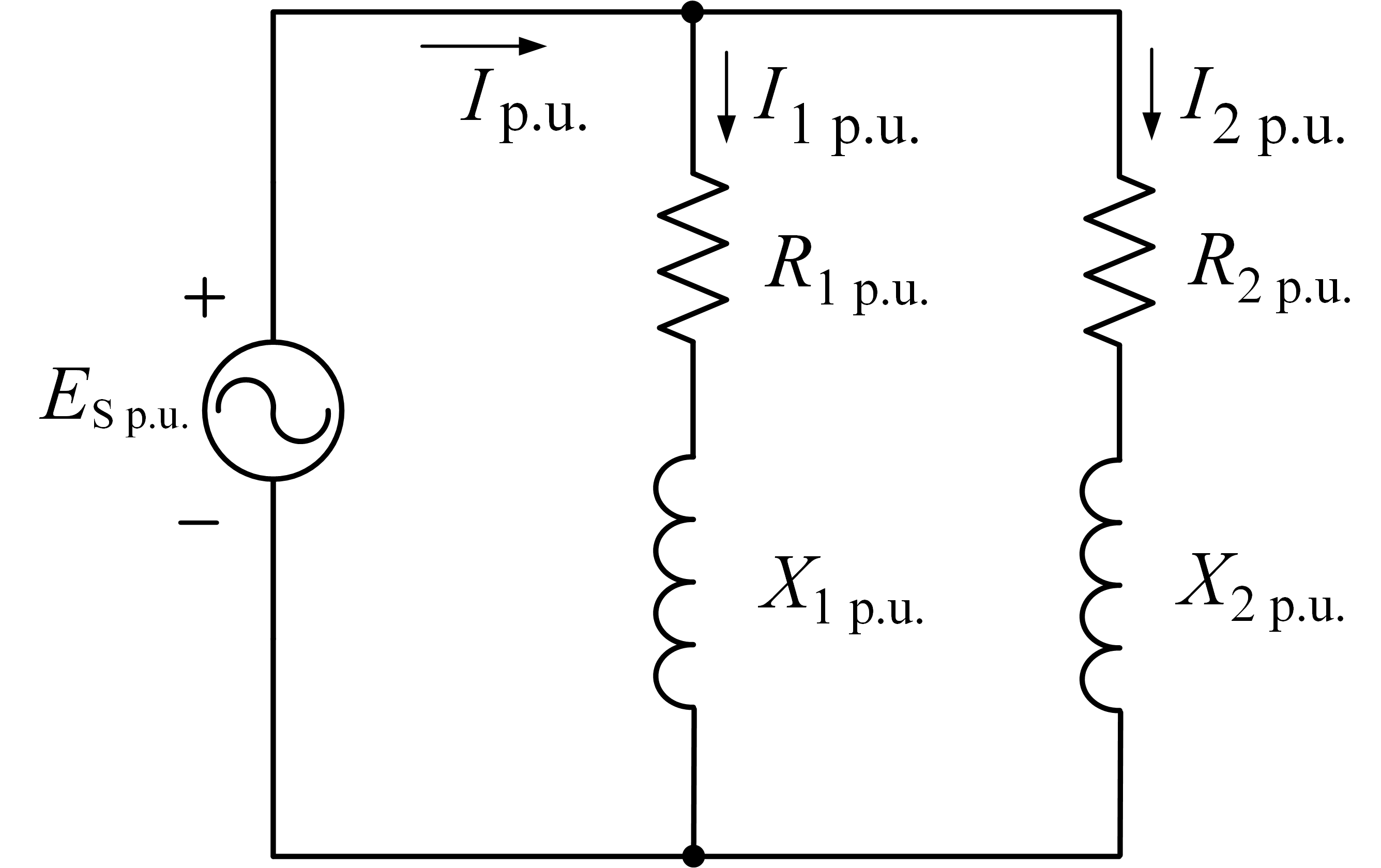선 전압이 22.9[kV]인 3상 전원이 병렬로 연결된 2개의 부하에 공급되고 있다. (단위 값 변환시 3상 300[kVA], 22.9[kV]를 기준 값으로 한다.)
- 부하1 : 300[kVA] (역률 0.8 지상)
- 부하2 : 150[kVA] (역률 0.6 지상)
- 부하를 임피던스로 표현하고 회로도를 작성하여라.
- 부하 임피던스를 단위 값으로 변환하여라.
- 각 부하에 흐르는 실제 전류 값을 단위법을 이용하여 구하여라.
풀이
1. 부하를 임피던스로 표현하고 회로도를 작성하여라.
부하 1과 부하2의 임피던스 : Z1=R1+jX1, Z2=R2+jX2, 각 부하가 소모하는 상당 복소 전력 : SL1, SL2이라고 하자. 상당 전원의 위상을 0으로 가정하면 다음과 같다.
ES=ES0=ES=322.9×103=13.2[kV]
SL1, SL2은 다음과 같이 구할 수 있다.
SL1=3SL13ϕ(cosθ1+jsinθ1)=3300×103×(0.8+j0.6)=100×(0.8+j0.6)[kVA]
SL2=3SL23ϕ(cosθ2+jsinθ2)=3150×103×(0.6+j0.8)=50×(0.6+j0.8)[kVA]
이로부터 각 부하의 임피던스는 다음과 같이 구할 수 있다.
Z1=[SL1ES2]∗=[100×103×(0.8+j0.6)(13.2×103)2]∗=1.74×(0.8+j0.6)×103=1.39+j1.04[kΩ]=R1+jX1
Z2=[SL2ES2]∗=[50×103×(0.6+j0.8)(13.2×103)2]∗=3.48×(0.6+j0.8)×103=2.08+j2.78[kΩ]=R2+jX2
회로도는 다음과 같다.

2. 부하 임피던스를 단위 값으로 변환하여라.
먼저 부하 1의 부하 용량을 전력 기준 값으로 선정하고 선 전압을 전압의 기준 값으로 선정하고, 이로부터 상당 기준 값을 유도한다.
SB=3SB3ϕ=3300×103=100[kVA]
VB=3VBll=322.9×103=13.2[kV]
이로부터 부하 전력의 단위 값을 다음과 같이 구할 수 있다.
SL1,pu=SBSL1=0.8+j0.6[pu]
SL2,pu=SBSL2=0.3+j0.4[pu]
이로부터 부하 임피던스 기준 값을 다음과 같이 구할 수 있다.
ZB=SBVB2=100×103(13.2×103)2=1.74[kΩ]
IB=VBSB=13.2×103100×103=7.57[A]
기준 값을 실제 값에 적용하여 다음과 같이 단위 값을 구한다.
Z1pu=ZBZ1=1.74×103(1.39+j1.04)×103=0.8+j0.6[p.u.]
Z2pu=ZBZ2=1.74×103(2.08+j2.78)×103=1.2+j1.6[p.u.]
위의 결과로부터 아래와 같은 임피던스도를 구할 수 있다. 회로에서 각 요소의 값은 다음과 같다.
R1pu=0.8,X1pu=0.6R2pu=1.2,X2pu=1.6

3. 각 부하에 흐르는 실제 전류 값을 단위법을 이용하여 구하여라.
회로도에서 각 부하에 흐르는 전류는 다음과 같이 구할 수 있다.
I1pu=[ES,puSL1,pu]∗=[1.00.8+j0.6]∗=0.8−j0.6=1−36.9∘[p.u.]
I2pu=[ES,puSL2,pu]∗=[1.00.3+j0.4]∗=0.3−j0.4=0.5−53.1∘[p.u.]
각 부하에 흐르는 전류의 실제 값은 다음과 같이 기준 값을 곱해줌으로써 구할 수 있다.
I1=I1puIB=(0.8−j0.6)×7.57=7.57−36.9∘[A]
I2=I2puIB=(0.3−j0.4)×7.57=3.79−53.1∘[A]


Login to write a comment.